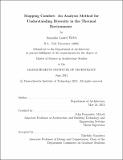Mapping comfort : an analysis method for understanding diversity in the thermal environment
Author(s)
Webb, Amanda Laurel
DownloadFull printable version (12.40Mb)
Other Contributors
Massachusetts Institute of Technology. Dept. of Architecture.
Advisor
John Fernandez.
Terms of use
Metadata
Show full item recordAbstract
Our thermal experience is never neutral. Whether standing near a cold window in the winter, or in the shade on a sunny day, we constantly experience a rich set of thermal stimuli. Yet, many of the tools used in professional practice to analyze and design thermal environments in buildings do not account for the richness of our thermal experience. This disconnect between our analysis tools and our experience results in buildings that use more energy than they should, and that leave occupants dissatisfied with their thermal environment. This thesis seeks to bridge the gap between our thermal experience and our building thermal analysis tools. A unique methodology has been developed that produces mapping of thermal comfort parameters in all three spatial dimensions, as well as over time. Both heat balance and adaptive comfort indices have been incorporated into the methodology. An accompanying software program, called cMap, has been developed to illustrate the ways that this methodology can be used with existing energy analysis software and to demonstrate how it can fit into existing analysis workflows in professional practice.
Description
Thesis (S.M. in Architecture Studies)--Massachusetts Institute of Technology, Dept. of Architecture, 2012. Cataloged from PDF version of thesis. Includes bibliographical references (p. 67-70).
Date issued
2012Department
Massachusetts Institute of Technology. Department of ArchitecturePublisher
Massachusetts Institute of Technology
Keywords
Architecture.